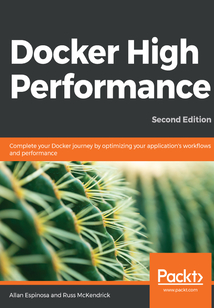舉報(bào) 

會(huì)員
Docker High Performance(Second Edition)
Dockerisanenterprise-gradecontainerplatformthatallowsyoutobuildanddeployyourapps.Itsportableformatletsyourunyourcoderightfromyourdesktopworkstationstopopularcloudcomputingproviders.ThiscomprehensiveguidewillimproveyourDockerwork?owsandensureyourapplication'sproductionenvironmentrunssmoothly.ThisbookstartswitharefresheronsettingupandrunningDockeranddetailsthebasicsetupforcreatingaDockerSwarmcluster.YouwillthenlearnhowtoautomatethisclusterbyusingChefServerandCookbook.Afterthat,youwillruntheDockermonitoringsystemwithPrometheusandGrafana,anddeploytheELKstack.YouwillalsolearnsometipsforoptimizingDockerimages.AfterdeployingcontainerswiththehelpofJenkins,youwillthenmoveontoatutorialonusingApacheJMetertoanalyzeyourapplication'sperformance.YouwilllearnhowtouseDockerSwarmandNGINXtoload-balanceyourapplicationandhowcommondebuggingtoolsinLinuxcanbeusedtotroubleshootDockercontainers.Bytheendofthisbook,youwillbeabletointegratealltheoptimizationsthatyouhavelearnedandputeverythingintopracticeinyourapplications.
目錄(112章)
倒序
- coverpage
- Title Page
- Copyright and Credits
- Docker High Performance Second Edition
- About Packt
- Why subscribe?
- Packt.com
- Contributors
- About the authors
- About the reviewer
- Packt is searching for authors like you
- Preface
- Who this book is for
- What this book covers
- To get the most out of this book
- Download the example code files
- Download the color images
- Conventions used
- Get in touch
- Reviews
- Preparing Docker Hosts
- Preparing a Docker host
- Enabling remote access
- Setting up a certificate authority
- Enabling remote access in Docker Engine
- Connecting remotely from the Docker client
- Building a Docker Swarm cluster
- Summary
- Configuring Docker with Chef
- Importance of configuration management
- Using Chef
- Signing up for a Chef server
- Setting up our workstation
- Bootstrap nodes
- Configuring the Docker host
- Writing Chef recipes
- Push Chef policies
- Initializing Docker Swarm
- Alternative methods
- Summary
- Monitoring Docker
- The importance of monitoring
- Collecting metrics with Prometheus
- Exposing Prometheus's metrics
- Scraping and visualizing metrics
- Consolidating logs in an ELK stack
- Deploying Elasticsearch Logstash and Kibana
- Forwarding Docker container logs
- Other monitoring and logging solutions
- Summary
- Optimizing Docker Images
- Reducing deployment time
- Improving image build time
- Using registry mirrors
- Reusing image layers
- Reducing the build context size
- Using caching proxies
- Reducing Docker image size
- Chaining commands
- Separating build and deployment images
- Guide to Optimization
- Summary
- Deploying Containers
- Deploying and configuring Jenkins
- Deploying the Jenkins container
- Finishing the Jenkins Configuration
- Setting up our Docker credentials within Jenkins
- Building and deploying a container
- Preparing our application
- Creating a Jenkins job
- Running the Pipeline
- Summary
- Benchmarking
- Setting up Apache JMeter
- Deploying a sample application
- Installing JMeter
- Building a benchmark workload
- Creating a test plan in JMeter
- Analyzing benchmark results
- Viewing the results of JMeter runs
- Calculating throughput
- Plotting response time
- Observing performance in Grafana and Kibana
- Tuning the benchmark
- Increasing concurrency
- Running distributed tests
- Other benchmarking tools
- Summary
- Load Balancing
- Preparing application backends
- Balancing load with NGINX
- Scaling out our Docker applications
- Deploying with zero downtime
- Other load balancers
- Summary
- Troubleshooting Containers
- Inspecting containers with the docker exec command
- Debugging from outside Docker
- Tracing system calls
- Analyzing network packets
- Observing block devices
- Other container debugging tools
- Summary
- Onto Production
- Performing web operations
- Supporting web applications with Docker
- Deploying applications
- Scaling applications
- Further reading
- Summary
- Other Books You May Enjoy
- Leave a review - let other readers know what you think 更新時(shí)間:2021-06-24 14:32:59
推薦閱讀
- Design for the Future
- 手把手教你學(xué)AutoCAD 2010
- 教父母學(xué)會(huì)上網(wǎng)
- Windows 8應(yīng)用開發(fā)實(shí)戰(zhàn)
- 大數(shù)據(jù)技術(shù)入門(第2版)
- Android游戲開發(fā)案例與關(guān)鍵技術(shù)
- 信息物理系統(tǒng)(CPS)測(cè)試與評(píng)價(jià)技術(shù)
- MCGS嵌入版組態(tài)軟件應(yīng)用教程
- Building a BeagleBone Black Super Cluster
- Mastering pfSense
- 單片機(jī)原理實(shí)用教程
- Mastering Geospatial Analysis with Python
- 電腦上網(wǎng)入門
- Redash v5 Quick Start Guide
- Mastering MongoDB 4.x
- Arduino創(chuàng)意機(jī)器人入門:基于Mind+
- 系統(tǒng)與服務(wù)監(jiān)控技術(shù)實(shí)踐
- 51單片機(jī)應(yīng)用開發(fā)實(shí)戰(zhàn)手冊(cè)
- Architecting Cloud Computing Solutions
- Practical Data Science Cookbook
- VRay 1.5R2完全自學(xué)攻略
- Network Security with pfSense
- 圖解傳感器與儀表應(yīng)用(第2版)
- 搞定J2EE核心技術(shù)與企業(yè)應(yīng)用
- 多媒體技術(shù)基礎(chǔ)及應(yīng)用
- System Center 2016 Virtual Machine Manager Cookbook(Third Edition)
- 零基礎(chǔ)學(xué)三菱PLC編程:入門、提高、應(yīng)用、實(shí)例
- 大數(shù)據(jù)可視化技術(shù)
- 案例解說(shuō)Visual C++典型控制應(yīng)用
- Voicebot and Chatbot Design

